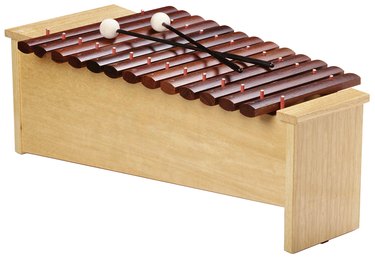Things You'll Need
Dowels
Saw
Rubber balls
Drill
Gorilla glue
Yarn

Xylophones can produce a range of sounds, and that's partly due to the type of mallets used to play the instrument. Heavy mallets deliver loud sounds, and very light ones can create hollow metallic sounds. Mallets are composed of a ball on the hitting end, connected to a long, thin stick. Various light and heavy woods can be used for the shafts, and the balls can be composed of rubber, plastic, resin, or other materials capable of bouncing or striking on the xylophone keys. Try a variety of combinations to experiment with the sounds they create.
Step 1
Select an assortment of dowels in widths between ¼ inch and ½ inch; they are usually sold in one-yard lengths. Feel the weight of the dowels in your hand to make your selection.
Video of the Day
Step 2
Cut dowels to make the mallet shafts. Use your saw and cut 8-inch long dowels for child-size instruments. Make 16-inch lengths for adults and students with longer arm reach.
Step 3
Drill a shallow hole in one end of the ball, about 1/4 inch through the center of each ball. Use the drill and carefully poke it into the ball to create a small hole, one that is smaller than the diameter of the dowel that will fit into it.
Step 4
Apply a small amount of Gorilla glue into the hole. Use the applicator, or push it in using a cotton swab. Attach the ball to one end of each dowel.
Step 5
Insert the dowel into the ball hole. Push it in to the maximum extension to ensure a good fit. Hold in place for about a minute, and then allow it to dry for up to one hour.
Step 6
Wind yard lightly around the entire exterior of a lightweight ball to produce soft tones. Apply a small amount of the Gorilla glue onto the lower surface of the ball, near the shaft, and then wrap the yarn systematically to fully coat the surface. Do at least two rounds of yarn to ensure that the ball does not poke through the yarn during play.
Tip
Hobby and hardware stores generally sell wooden and plastic dowels.
Choose mallet lengths compatible with the size of your xylophone and the musician.
Make mallet shafts that are long enough for you to stand in a comfortable position over the xylophone, while at the same time extending to the various hitting positions on the keys.
Use thick, soft mallet tips for smooth bass tones. Try stiff plastic that lacks cushioning if you want to achieve thin metallic sounds.
Medium or heavy balls will produce warm and rich tones on your xylophone.
Get heavy and thicker dowels for xylophones played on an open marching field. Elect lighter weights for a soft metallic sounds, or for indoor use, such as for a jazz dinner club.
Dmitri Shostakovich marveled at their staccato capacity and used xylophones in his symphonic works to create a bizarre blend of sounds to evoke emotions and images for his audience.
Video of the Day